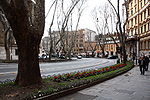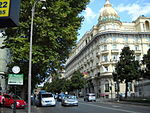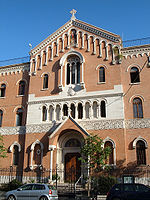Embassy of the United States to the Holy See
The Embassy of the United States of America to the Holy See (or Embassy Vatican for short) is the diplomatic mission of United States of America to the Holy See, a term referring to the central government and universal reach of the Roman Catholic Church. The current embassy moved to new headquarters in September 2015 in a separate building on the same compound as the United States Embassy Rome. The embassy was previously located on Aventine Hill in the Villa Domiziana in Rome, Italy, which was built as a private residence in 1953. In 1994, the U.S. government acquired the property as the new chancery for embassy. On October 16, 2017, Callista L. Gingrich was confirmed by the U.S. Senate as the next Ambassador to the Holy See. On October 8, 2021, President Biden nominated former U.S. senator Joe Donnelly to be ambassador to the Holy See, and the U.S. Senate confirmed the nomination on January 20, 2022. Donnelly presented his credentials to Pope Francis on April 11, 2022.The embassy is a part of the "Tri-Mission Community" in Rome, the other two being the Embassy of the United States, Rome and the United States Mission to the U.N. Agencies in Rome.
Excerpt from the Wikipedia article Embassy of the United States to the Holy See (License: CC BY-SA 3.0, Authors).Embassy of the United States to the Holy See
Via Sallustiana, Rome Municipio Roma I
Geographical coordinates (GPS) Address Phone number Website External links Nearby Places Show on map
Geographical coordinates (GPS)
| Latitude | Longitude |
|---|---|
| N 41.9066051 ° | E 12.4918327 ° |
Address
Ambasciata degli Stati Uniti presso la Santa Sede
Via Sallustiana 49
00187 Rome, Municipio Roma I
Lazio, Italy
Open on Google Maps








